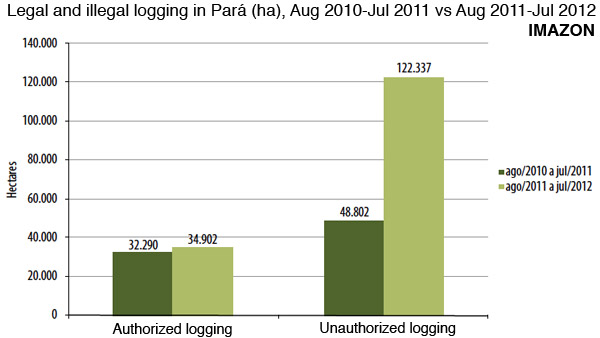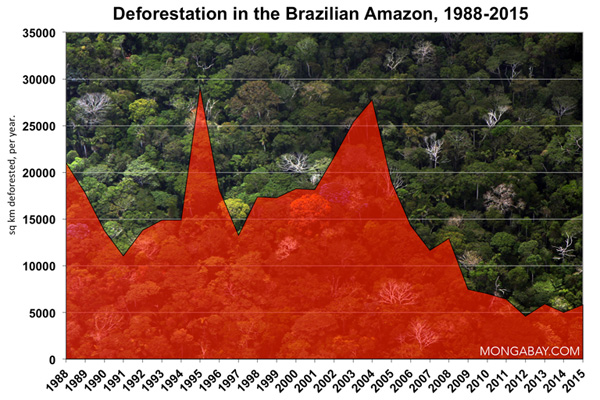Illegal logging remains pervasive in the Brazilian state of Pará, finds an assessment released Monday by Imazon.
Analyzing satellite data and records from Pará’s environmental agency Sema, the Brazil-based NGO found that 78 percent of logging documented via satellite between August 2011 and July 2012 was illegal. Some 122,337 hectares of rainforest was logged during the period, a 151 percent rise over a year earlier, when 48,802 ha were illegally harvested.
Illegal logging far outpaced legal logging in the state: the area illegally cut was three-and-a-half times larger than the 34,902 ha where sanctioned logging took place.
15 percent of illegal logging occurred in the municipality of Portel. Paragominas, the municipality that has been heralded for its progress in reducing deforestation since 2009, accounted for less than 4 percent of illegal logging.


40 percent of deforestation in the Brazilian Amazon since 2004 — 44,361 square kilometers — has occurred in Pará.
Only 2,055 ha of illegal logging occurred within indigenous reservations in the state. In contrast, more than 8,000 ha of conservation areas were illegally logged.
Almost a quarter of illegal logging took place in areas set aside for colonization under Brazil’s agrarian reform program.
The study found that legal concessions were pretty well managed, with 87 percent of operating consistently with their management plans. Less than 300 ha of the 476,454 ha under logging concessions was deforested over the past five years.

Deforestation and illegal logging in Para, Brazil. Background image courtesy of Google Earth, data from INPE and IMAZON.
The increase in illegal logging comes despite an overall drop in deforestation during the period: Pará saw its annual forest loss fall 42 percent between 2010/2011 and 2011/2012, while the Brazilian Amazon as a whole experienced a 29 percent dip. Deforestation in Brazil is down sharply since last peaking in 2004.
Still the rise of illegal logging suggests that Pará may be at risk of seeing a reversal in its downward trend in deforestation. Studies have shown that logged areas have a much higher likelihood of future deforestation relative to untouched forests. Furthermore, forests degraded by logging are more vulnerable to drought and fire, which have been worsening in the region over the past decade.

The Amazon is Earth’s largest rainforest. More than three-fifths of the Amazon lies within the borders of Brazil.
CITATION: André Monteiro, Dalton Cardoso, Denis Conrado, Adalberto Veríssimo & Carlos Souza Jr. (2013). Transparência Manejo Florestal Estado do Pará – 2011 a 2012. Imazon: Belém.
Related articles
Has Brazil turned against its progressive environmental policies?

(09/30/2013) Last year, Brazil rolled back crucial parts of its landmark Forestry Code, potentially opening vast tracts of forest for destruction; it is also moving ahead on a number of Amazon dams, including the infamous Belo Monte, despite international condemnation and conflict with indigenous people. Meanwhile, a new law under consideration proposes allowing large-scale mining in protected areas. Given this a new paper in mongabay.com’s open access journal Tropical Conservation Science argues that Brazil has thrown off its once admired mantle of environmental legislation, imperiling hundreds of thousands of species in the most biodiverse country on Earth.
Brazil’s satellite data suggests rise in Amazon deforestation over past year

(09/12/2013) Deforestation in the Brazilian Amazon appears to have risen significantly over the past year, according to data released by the country’s space agency, INPE. Data aggregated from INPE’s monthly deforestation alert system shows a 34 percent rise for the 12 months ended July 31, 2013 relative to the year-earlier period.
Brazil establishes 2 Amazon parks covering 2.4m acres
(09/10/2013) The Brazilian government has designated 952,000 hectares of remote public land in the Amazon as two new protected areas.














